Fourth of July without the crowds in Redwood National and State Parks' backcountry
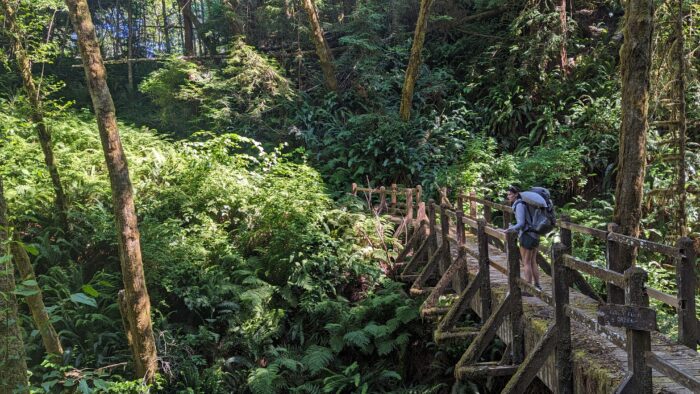
It was very much a typical Fourth of July celebration. We played outside, splashed in the water, and shared food across a picnic table. Except instead of raucous crowds, booming fireworks, and sloshing beer, we were occupied with the lyrical trickle of a creek, the feel of soft moss on tree trunks, the dimensions of green ferns illuminated by golden sunlight. We celebrated our country but focused less on the flag and more on another national icon: the redwoods.
Our holiday was spent at Elam Camp, in the backcountry of Redwood National Park, part of the Redwood National and State Parks system. Within the old-growth forest, we were able to reexamine what the Fourth of July meant to us, reconnect with the soil of this country, and reflect on the many things we’re grateful for in this turbulent America.
Elam Camp appealed to us because it was close to Redwood Creek and allowed us to escape the crowds and explore the backcountry. Though it’s designated for up to three groups, we were fortunate enough to have the camp entirely to ourselves. The only obnoxious guest we were told to worry about was a too-curious black bear, but we went the entire trip without a sighting, much to our dismay.
We arrived late in the afternoon, after hiking almost 7 miles along the overgrown trail from the Tall Trees Grove (see Tips below for why we chose this trailhead). The path was thick with berry bushes, the bridges were partially broken and begged caution. But the wild trek made us appreciate our arrival at camp even more.
We chose a tent site surrounded by alder trees and sword ferns, with a scattering of majestic redwoods that stood like the pillars of the Acropolis. We opened our river-chilled bottles of bright blue electrolyte water, drank in the energy of salt and sugar, and called ourselves lucky.
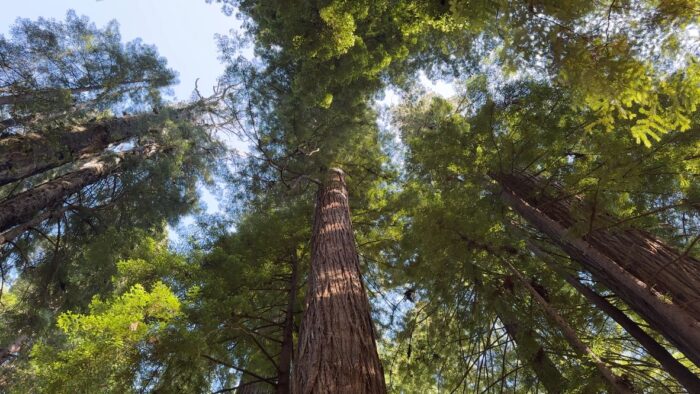
Dusk began to settle across the forest as we boiled water on our camp stove. Over the steady bubbling, I realized the typical noises of the Fourth of July were missing. It was only every so often that the muffled boom of distant fireworks would break the silence. Closer by, an owl hooted, as if accentuating the calm, and seconds later its companion replied.
My eyes kept adjusting to the fading light of day, trying to soak in the magical forest. The redwood landscape surrounding Elam Camp was ancient, still, and settled in a way that made the nearly two and a half centuries since America claimed independence feel fleeting. Beneath the towering trees, our country’s challenges momentarily receded from my mind. I had found absolute peace in the backcountry.
Within the old-growth forest, we were able to reexamine what the Fourth of July meant to us, reconnect with the soil of this country, and reflect on the many things we’re grateful for in this turbulent America.
This contentment could not be celebrated without celebrating those who stewarded these forests for millennia: the Yurok, Tolowa, and Chilula peoples, who regard the redwoods as sacred living beings. I also gave thanks to those who have fought to save the ancient trees, including Save the Redwood League, which has protected more than 220,000 acres of redwood forest since its founding in 1918. Without this tireless work, the remaining old-growth forests might not exist.
Our Fourth of July was defined by wildness, adventure, and a deep appreciation for America’s natural gems. The redwoods are special—special enough to stand tall for thousands of years, special enough to save, special enough to soar above political lines and bring communities together. Sitting beneath them was a spectacular way to pay tribute to our nation.
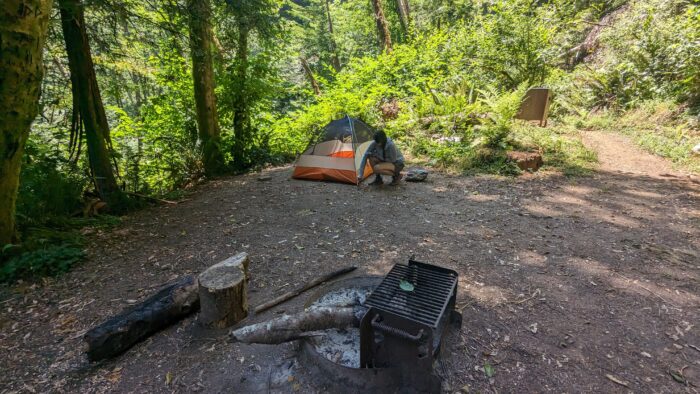
Tips for visiting Elam Camp
Like other designated backcountry sites within the national park, Elam Camp is equipped with picnic tables, fire pits, a pit toilet, and food storage lockers. All food, trash, cooking equipment and utensils, and scented toiletries must be secured—both in your camp and in your car.
• A permit is required for Elam Camp and can be reserved via the Redwood Parks Conservancy’s backcountry permits page. Permits are easy and free to obtain, but it’s recommended to reserve three to four weeks in advance.
• Planning our route was more challenging. The National Parks Service website offers maps, mileage, and other backcountry camping information, but it took us a while to decide which trailhead we should use to start our hike along Redwood Creek Trail. Should we make the easier 3-mile trip south from Redwood Creek Trailhead? Or go for a more challenging adventure by starting at the Tall Trees Trailhead and trekking nearly 7 miles north? In the end we chose the Tall Trees Trailhead, because the hike from here takes you through one of the park’s least visited old-growth redwood groves, which includes some of the tallest trees on the planet.
• Starting from Tall Trees Grove also provides some peace of mind, as the trailhead parking lot is more secure. (The NPS website warns of frequent car break-ins at Redwood Creek Trailhead because it’s easier to access.) A parking permit is required for Tall Trees Grove—without it, you won’t receive a gate code to access the parking lot.
• Note that the footbridges across Redwood Creek are seasonal and are usually only in place from June to September. During the winter rainy season or high flow stages, the creek may be impossible—and dangerous—to cross. All the more reason to plan a Fourth of July visit.
• Avoid campsite confusion: At the junction of Redwood Creek Trail and the Elam Camp Loop, there is a sign that says: “Elam Horse Camp; hikers use gravel bar for camping.” If you have a permit for Elam Camp, you are permitted to camp here. The reference to hikers applies to hikers with dispersed camping permits (not Elam Camp permits), which allows them to camp along the Redwood Creek gravel bars only.

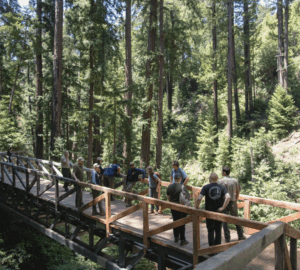
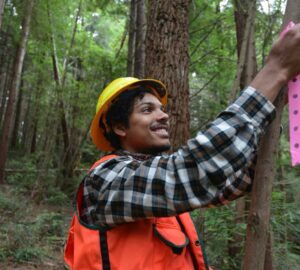
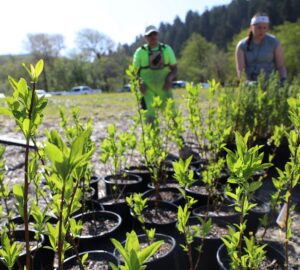

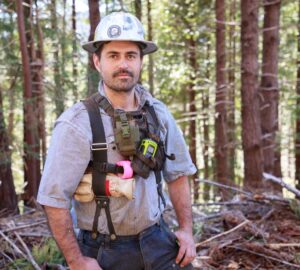

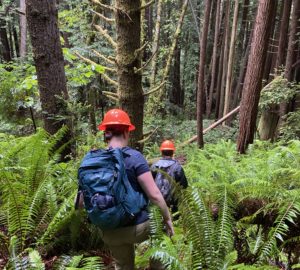

2 Responses to “Summer camping in Redwoods National Park”
HENRY ALVIN ROSENFELD
Can I go in October, too? I am dog & cat sitting in Occidental then and wanted to zip up for a night. Thanks for great descriptions and help!
Ande Kobek
Hello we’ve been enjoying the Redwoods for 40+ years. So many of our secret gems have been let out of the bag. We do our best to not exploit them and my continued hope at 65 is that all the travel magazines, etc. keep an eye on that.